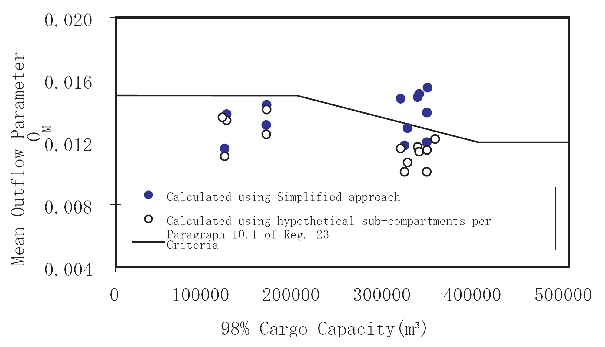6.1 There were no available data on the percentage
of outflow from a tank subject to side damage, and theoretical calculation
of the portion of retained liquid was considered impractical. Therefore,
it is conservatively assumed that for side damage, total (100%) of
the oil outflows from each damaged cargo tank. This is consistent
with the approach applied in the Revised Interim Guidelines.
6.2 In accordance with paragraph 6 of regulation 23, the mean outflow
from side damage is calculated as follows:
Where Ps(i) is the probability
of penetrating cargo tank i from side damage, and Os(i) is
the outflow from side damage to cargo tank i.
6.3 In accordance with the simplified approach
prescribed in regulation 23,
the probability that damage will extend transversely into a cargo
tank is calculated based on the minimum horizontal distance between
the compartment and the side shell. Where the distance to the shell
is not uniform, this assumption will result in over-estimates of oil
outflow. This is most evident in way of the forward and aft cargo
tanks, where hull curvature is most pronounced.
6.4 More rigorous calculations carried out to
validate the methodology showed that tankers with two continuous longitudinal
bulkheads within the cargo tanks (i.e. with a three across cargo tank
arrangement) are most affected by this conservative approach . Figure 13 presents the mean outflow
parameters for a series of tankers calculated using the simplified
approach as per regulation 23 without
consideration of the C3 factor, and also calculated based on the hypothetical
sub-compartment methodology specified in paragraph 10.1 of regulation 23. The vessels with
capacities of under 200,000 m3 which have a single centreline
bulkhead show good correspondence. The simplified regulation 23 approach overestimates
the outflow performance of vessels over 300,000 m3 capacity,
all of which have two longitudinal bulkheads within the cargo tanks.
Therefore, in the case of such designs the outflow from side damage
is multiplied by the C3 factor 0.77.

Comparison of calculations using the simplified method and hypothetical sub-compartments